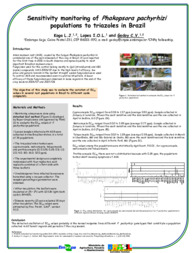Sensitivity monitoring of Phakopsora pachyrhizi populations to triazoles in Brazil.
Sensitivity monitoring of Phakopsora pachyrhizi populations to triazoles in Brazil.
Author(s): KOGA, L. J.; LOPES, I. de O. N.; GODOY, C. V.
Summary: Asian soybean rust (ASR) reported in 2001 in South America spread to Brazilian producing areas and is considered one of the main diseases of the crop. Fungicides used for the control belong to QoI (strobilurins) and SBI (azole) compounds. A weaker efficacy of straight azole was observed at some regions in the end of the crop season 2006/2007. To determine whether the problem observed was due to the resistance, a sensitivity monitoring test was carried out in 2008/2009 to detect possible changes in the EC50 values of the fungus population. The test was done according to FRAC methodology. Leaves samples infected with Phakopsora pachyrhizi were sent from nine Brazilian states, in a total of 36 populations, and the spores collected were inoculated in detached leaves treated with fungicides. The triazoles tested were cyproconazole, metconazole, tebuconazole, and prothioconazole (0; 0.125; 0.25; 0.5; 1.0; 2.0; 4.0; 8.0; 16.0; 32.0 ppm). Disease severity was evaluated 15 days after inoculation. The EC50 values were estimated by Proc Probit, SAS®. Differences in EC50 values among the populations were statistically significant (P < 0.01). The EC50 for cyproconazole and metconazole ranged from 0.06 to 1.37 ppm and from 0.02 to 3.89 ppm, respectively. For tebuconazole, EC50 ranged from 0.02 to 1.28 ppm. For prothioconazole, there wasn’t a distribution of EC50 values because, with 0.25 ppm, the populations tested didn’t develop symptoms of ASR. The results showed an oscillation of EC50 values in the P. pachyrhizi population from different locations during the crop season.
Publication year: 2010
Types of publication: Abstract in annals or event proceedings
Unit: Embrapa Soybean
Observation
Some of Embrapa's publications are published as ePub files. To read them, use or download one of the following free software options to your computer or mobile device. Android: Google Play Books; IOS: iBooks; Windows and Linux: Calibre.
Access other publications
Access the Agricultural Research Database (BDPA) to consult Embrapa's full library collection and records.
Visit Embrapa Bookstore to purchase books and other publications sold by Embrapa.

